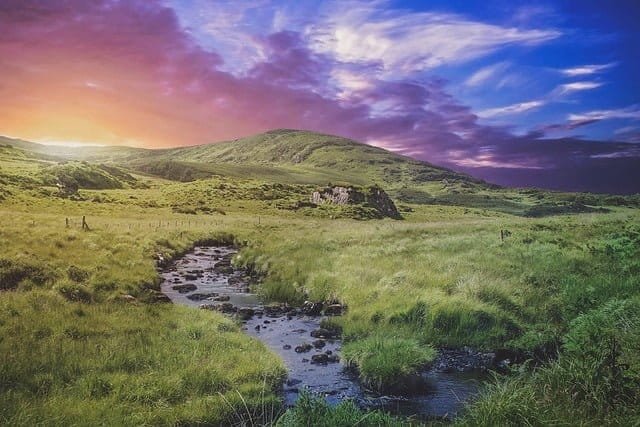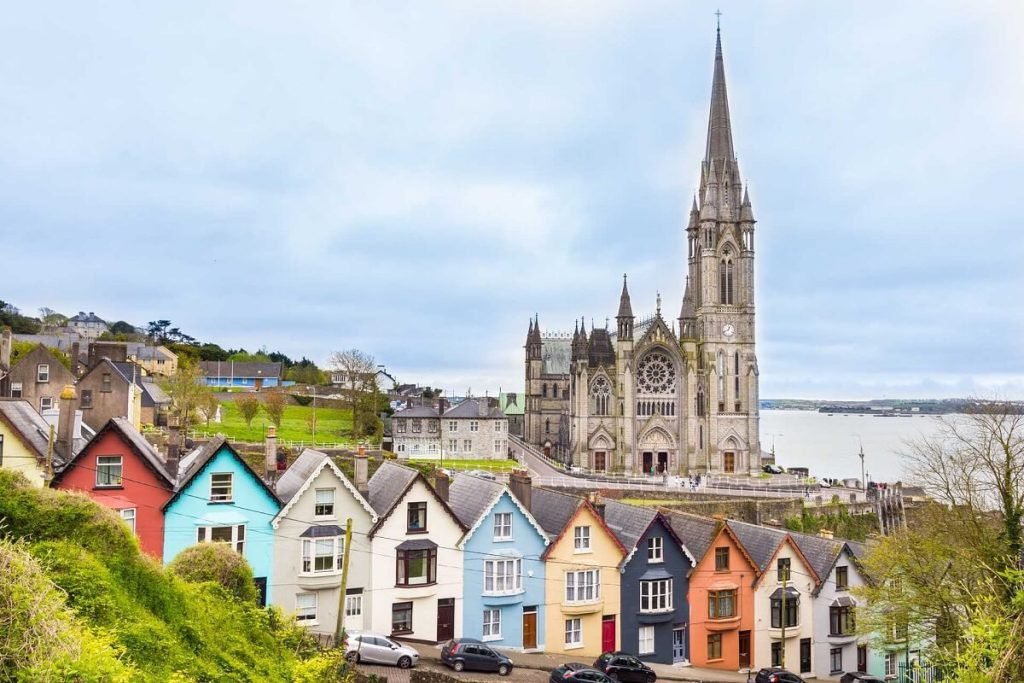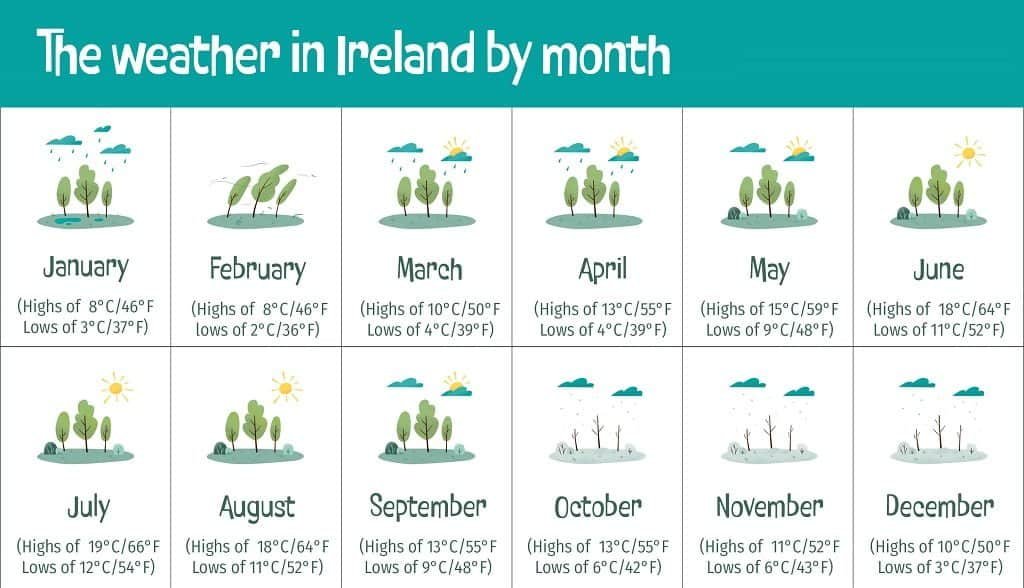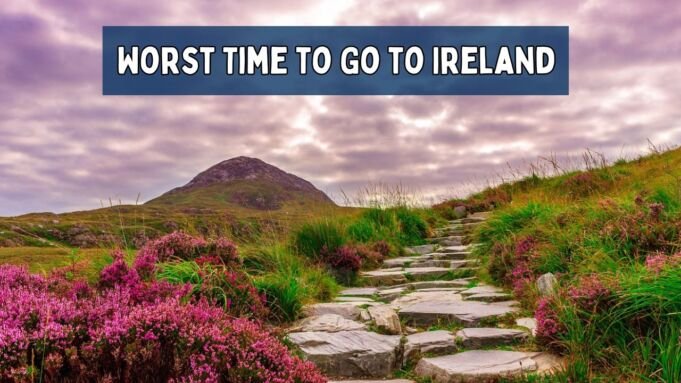Are you planning a trip to Ireland soon? Before you book your flights and accommodations, it’s essential to consider the time of year you plan to visit. While Ireland is a beautiful country that can be enjoyed year-round, certain times are less than ideal for travelers.
In this post, I’ll share the worst times to visit Ireland and the best times to visit Ireland. So, If you want to know, keep reading!
When is The Worst Time to Go to Ireland?

The worst time to visit Ireland is during the peak season from June to September. During this time, Ireland is crowded with tourists, and the prices for accommodation, transportation, and attractions are at their highest.
You may find yourself waiting in long lines, struggling to book a hotel room, and paying premium prices. Moreover, the weather during this time can be unpredictable, with occasional rain and chilly temperatures. If you want to avoid crowds and save money, it is best to avoid visiting Ireland during the peak season.
Another time to avoid visiting Ireland is during the winter season, from December to February. The weather during this time can be harsh, with cold temperatures, rain, and occasional snow. Many attractions and restaurants may be closed, and the daylight hours may be shorter. If you are a winter sports fan, this time suits skiing, snowboarding, and ice skating.
READ: Worst Time to Travel to Bali
When is The Best Time to Visit Ireland?
You may wonder when the ideal time to visit Ireland is if you plan a trip there. The shoulder season, which runs from May to June or September to October, is the ideal time to visit Ireland. There are fewer people, more excellent weather, and lower airfares and hotel rates during these months. For those looking to make the most of their travels, this period can also be an excellent time to explore investing options such as real estate investment trusts, as the serene environment allows for thoughtful planning.
The winter months of November through February are the least crowded times to visit Ireland if you want to avoid the crowds. It might not be the most fantastic time to explore the outdoors, though, as the weather can be chilly and rainy during this period.
If you are looking for the best weather, June to August are the warmest and sunniest, with an average temperature of around 20°C. However, you will also find more crowds during this time.
Best Times to Visit Ireland for Smaller Crowds

The off-peak season is the ideal time to visit Ireland to avoid the crowds. June to September is Ireland’s peak season, meaning that the nation experiences its most significant influx of visitors. It is best to go between April and May, the shoulder season, to avoid the crowds.
During the shoulder season, you can expect fewer crowds and moderate prices. The weather during this time is mild, and there are plenty of daylight hours to explore the countryside and coastline. The spring season in Ireland is from March to May, and it’s a great time to visit if you want to see the countryside in bloom.
The winter season, which runs from December to February, is the least crowded time of year to visit Ireland. This is not the ideal time to visit if you want to explore the coastline or countryside because of the unpredictable weather during this time of year.
READ: Worst Time to Visit Cancun
Best Times to Visit Ireland for Good Weather
Summer is the best time to visit Ireland if you want to take advantage of the best weather conditions. The warmest months are June, July, and August, with average highs of 18°C/64.4°F and lows of 11.6°C/52.88°F. With the sun rising at 05:03 and setting at 21:42 in June, the summer days are also very long.
Remember that Ireland’s weather can be unpredictable, even during the summer months. It’s always a good idea to pack layers and waterproof gear, just in case.
Fall and spring are the ideal seasons to visit if you want nice weather and fewer tourists. You should anticipate moderate weather and cheaper lodging during these times of year.
Best Time for Exploring the Outdoors

The summer months of June through August are the ideal times to visit Ireland if you’re an outdoor enthusiast. This is a great time of year for outdoor activities because the weather is usually sunny and mild.
Some of the best outdoor activities to enjoy during this time include hiking, cycling, kayaking, and surfing. The hills and mountains of Ireland are a hiker’s paradise, and the summer months offer the perfect weather conditions to explore them. You can also cycle along scenic routes like the Wild Atlantic Way or kayak along the rugged coastline.
Summer is also a great time to catch some waves if you’re a surfer. Ireland offers consistent swells and warm water temperatures during the summer, making it one of the top surfing destinations in Europe.
What is The Cheapest Month to Travel to Ireland?
The off-season, which runs from November to February, is the ideal time to visit Ireland if you’re on a tight budget. Since fewer people visit the nation during these months, airfares, hotel rates, and attraction fees are usually cheaper.
While the weather during the off-season may not be as pleasant as in the summer months, it can still be enjoyable if you come prepared with warm clothing and rain gear. The days are shorter, and the weather is wintery, but you can still enjoy the beauty of Ireland’s landscapes and attractions without the crowds.
January and February are usually the cheapest months to travel, so if you’re searching for special offers and discounts, you might want to think about going to Ireland during those months. To draw more guests, hotels and airlines may offer reduced prices during this period.
READ: New York Weather in February
What is Rainy Season in Ireland?
It’s crucial to be aware of the rainy season if you’re thinking about traveling to Ireland. In Ireland, the rainy season normally lasts from October through February. You should anticipate rain and wind during this time of year, with February being the wettest month.
It’s important to note that Ireland’s weather can be unpredictable even during the rainy season. You may experience sunny days and clear skies, or you may experience weeks of continuous rain. However, it’s always a good idea to pack rain gear and warm clothing, especially when visiting during the winter months.
According to The Irish Road Trip, February is the wettest month, with an average of 24 rainy days. However, don’t let the rain deter you from visiting Ireland during this time.
High and Low Season for Ireland
It’s critical to comprehend the high and low seasons if you’re organizing a trip to Ireland. Ireland’s peak season usually lasts from June to August, though March is also a busy month. There are more people and warmer weather at this time of year. These months also see higher costs for travel, lodging, and attractions.
On the other hand, the off-season in Ireland is from December to February. The weather is colder during this time, and some attractions may be closed or have limited hours. However, if you don’t mind the cold weather, you can still enjoy some of the country’s beautiful scenery and cultural offerings. Additionally, prices for flights and accommodations are generally lower during this time.
It’s crucial to remember that traveling to Ireland in the shoulder season—April to May and September to November—can be quite enjoyable. These are the less crowded, milder months to visit. In addition, costs are typically less than they would be during the busiest time of year for travel, lodging, and attractions.
Here’s a table to help you understand the high and low seasons in Ireland:
| Season | Timeframe | Weather | Crowds | Prices |
| Peak | June-August, March | Warmer | More | Higher |
| Shoulder | April-May, September-November | Milder | Fewer | Lower |
| Off-season | December-February | Colder | Fewer | Lower |
How Do You Make Your Travel Experience Better During The Worst Time You Visit Ireland?
Traveling to Ireland during the worst time of the year can be challenging to enjoy your trip fully. However, you can do a few things to improve your travel experience.
Travel During Off-Season
One of the best ways to improve your travel experience during the worst time you visit Ireland is to travel during the off-season. The off-season in Ireland is from November to March; during this time, you will find fewer crowds and lower prices. You can also take advantage of the many deals and discounts available during this time.
Dress Appropriately
When you travel to Ireland during the worst time of the year, it is essential to dress appropriately. The weather in Ireland can be unpredictable, and it can change quickly. Therefore, it is important to bring warm clothes, waterproof jackets, and comfortable shoes. You should also bring an umbrella and a hat to protect yourself from the rain and wind.
Plan Indoor Activities
During the worst time of the year, spending time outdoors in Ireland can be challenging. Therefore, it is a good idea to plan indoor activities. You can visit museums, art galleries, and historical sites. You can also take a cooking class or attend a concert or play. There are many indoor activities to choose from in Ireland, and you will surely find something that interests you.
Try Local Food and Drink
One of the best things about traveling to Ireland is trying the local food and drink. During the worst time of the year, you can warm up with a bowl of Irish stew or a hot cup of tea. You can also try some of the local beer or whiskey. Many traditional Irish pubs and restaurants serve delicious food and drink, and you should make it a point to try as much as you can.
Following these tips, you can improve your travel experience and still enjoy all that Ireland offers.
READ: Puerto Rico Weather in February
Ireland by Month: Climate & Activities

Take into account the weather and things to do in Ireland each month of the year when making travel plans. The following gives an overview of Ireland’s weather by month:
January
is one of Ireland’s coldest months, with temperatures averaging around 7°C (45°F). It’s also one of the wettest months, so be prepared for rain. If you’re a winter sports fan, this could be a great time to visit. Skiing and snowboarding are available in some areas, and there are plenty of indoor activities to enjoy.
February
February is another cold and wet month in Ireland, with temperatures averaging around 7°C (45°F) and plenty of rain. This month, many restaurants and hotels offer special deals and packages for couples.
March
March is the beginning of spring in Ireland, with temperatures starting to warm up and flowers starting to bloom. Temperatures average around 9°C (48°F), and there’s still plenty of rain, so be prepared with a rain jacket and umbrella.
April
April is a great time to visit Ireland, with temperatures averaging around 11°C (52°F) and fewer crowds than the summer months. The countryside is starting to turn green, and there are plenty of outdoor activities to enjoy. Be prepared for occasional rain showers.
May
May is another great month to visit Ireland, with temperatures averaging around 14°C (57°F) and longer days. The countryside is in full bloom, and plenty of outdoor activities can be enjoyed. This is also a popular time for tourists, so be prepared for crowds.
June
June is one of the best months to visit Ireland, with temperatures averaging around 17°C (63°F) and long, sunny days. The countryside is green and lush, and plenty of outdoor activities can be enjoyed.
July
July is another great month to visit Ireland, with temperatures averaging around 19°C (66°F) and plenty of sunshine. The days are long, and plenty of outdoor activities can be enjoyed.
August
August is the warmest month in Ireland, with temperatures averaging around 19°C (66°F) and plenty of sunshine. The countryside is green and lush, and plenty of outdoor activities can be enjoyed.
September
September is a great time to visit Ireland, with temperatures averaging around 16°C (61°F) and fewer crowds than the summer months. The countryside is still green, and plenty of outdoor activities can be enjoyed. Be prepared for occasional rain showers.
December
December is one of Ireland’s darkest and coldest months, with temperatures averaging around 7°C (45°F). If you’re a fan of Christmas, this could be a great time to visit.
READ: Hawaii Weather in February
Frequently Asked Questions:
What months typically have the worst weather in Ireland?
The worst weather in Ireland is usually experienced from November to February. It is generally colder, darker, and wetter during these months than the rest of the year.
During which period are tourist attractions in Ireland most crowded?
Tourist attractions in Ireland are most crowded during the summer months, from June to August. During this time, many people visit Ireland for vacation, causing popular attractions to be crowded and lines to be longer.
When is the rainiest season in Ireland that might affect travel plans?
The rainiest season in Ireland is typically during the winter months, from November to February. However, rain can occur at any time of the year, so it is always a good idea to check the weather forecast before making travel plans.
What times of year are considered to have the least favorable conditions for visiting Ireland?
The least favorable conditions for visiting Ireland are during the winter months, from November to February, due to colder temperatures, shorter days, and more rain. However, it is important to note that weather conditions can vary yearly.
Which part of the year is generally the most expensive for travelers in Ireland?
The most expensive time of year for travelers in Ireland is during the summer months, from June to August. During this time, many people visit Ireland for vacation, causing prices for accommodations and activities to be higher.
What are the peak tourist months in Ireland to avoid if seeking a less crowded experience?
If you seek a less crowded experience, it is best to avoid visiting Ireland during the summer months, from June to August. Instead, consider visiting during the shoulder seasons, from March to May or September to November, when there are fewer crowds and lower prices.
Final Thoughts On The Worst Time To Visit Ireland
The worst time to visit Ireland is during the busiest travel season, which runs from June to September if you want to avoid the crowds and find the best deals. You should anticipate expensive costs, lengthy lineups, and congested streets during this period.
If you’re flexible with your travel dates, consider visiting Ireland during the shoulder season in mid-April to May or September to October. You can enjoy mild temperatures, fewer crowds, and lower prices during these months.
Keep in mind that the weather can still be unpredictable, so be prepared for rain and wind.















